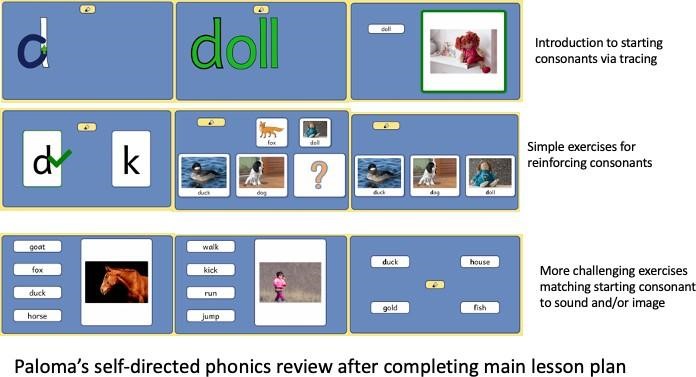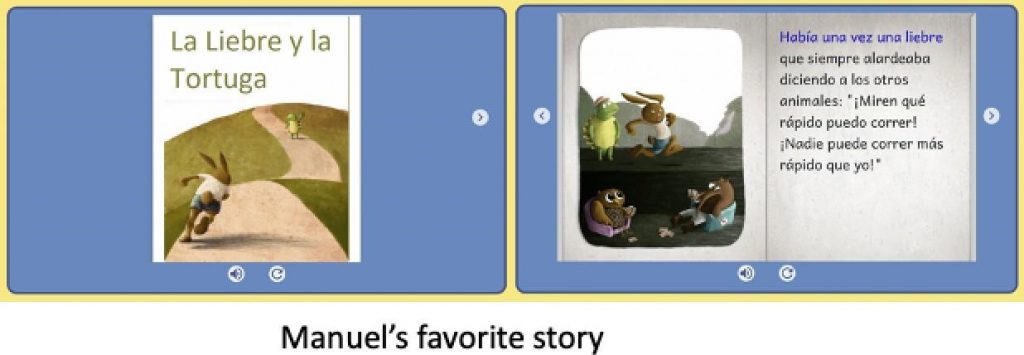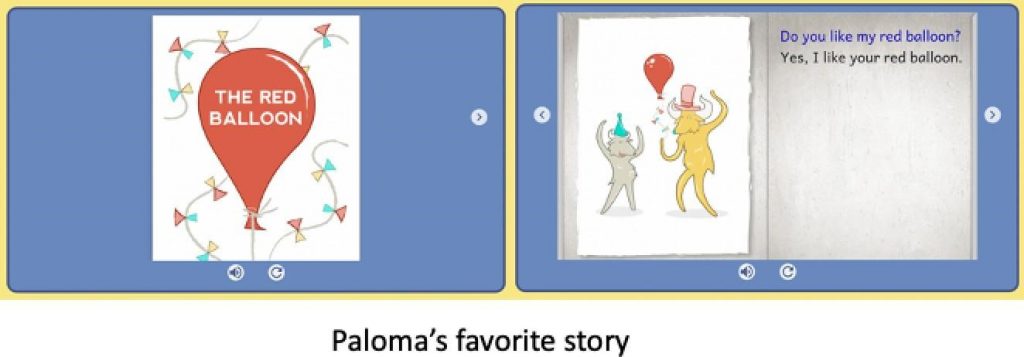Dear friend of GLEN World,
A unique feature of the GLEN Learn platform is the learner analytics that we gather. These analytics tell us a lot about our young learners’ engagement, progress, and the challenges along their learning journey, and enable us to improve our content to help them better. For example: how long did a learner take to complete an exercise, did they get it right or wrong, which lessons they had to try multiple times until completion, which stories and rhymes they liked the most, and so on.
While we have been busy refining our content and updating versions of the GLEN Learn app for different platforms, we recently looked at the learner analytics we gathered from local pilot deployments in California. We analyzed a pilot in the 2021-22 academic year in a Transitional Kindergarten classroom in the Lompoc Unified School District, California. In our last newsletter, we shared the overall statistics from the pilot and the teacher’s positive feedback. We are now in a position to share stories about our young learners who experienced the pilot, viewed solely through our analytics. We find these analytics-powered stories to be incredibly helpful in understanding the learning trajectory of each child, and a great complement to classroom observations and teacher interviews.
In the LUSD pilot, the teacher’s main role was to make sure that children accessed the GLEN Learn “station” for about 10 minutes a day. The learner analytics show how differently each child interacted with the content. In order to highlight the personalized learning experience enabled by GLEN Learn, let us tell you the story of three English Learners, two girls, who we will call Paloma and Maria, and a boy who we will call Manuel (the names have been changed in order to respect the children’s privacy).
Manuel: Manuel made steady progress on our lessons right from the start. He was done with our Main Lesson Sequence (which includes vocabulary and phonics) of 45 lessons in about a month, and then he raced through our lessons on Shapes and Numbers. He did our alphabet recognition lessons a few times, and then, towards the last couple of months of the pilot, discovered the separate Phonics module and went ahead and completed all 45 lessons, the only student to do so in his cohort. Seeing Manuel’s engagement and learning progress was very satisfying.

Paloma: Paloma did not know the material as well as Manuel, but she was determined and organized. She finished the 45 lessons in the Main Lesson sequence, and our relatively brief Shapes and Numbers module, in about a month and a half. However, some of the phonics-based lessons, especially those without images, were difficult for her, taking 5-10 minutes instead of the typical 2 minutes for our vocabulary lessons. She seems to have realized that, and right after finishing the main lesson sequence in Week 6, she returned to some of these more challenging lessons in Weeks 7-13 (now that’s a growth mindset!). Once she discovered our alphabet recognition lessons (which are grounded in the ABC song), she repeatedly went back to them—like many of her peers, she seems to have enjoyed playing the ABC song repeatedly. She also kept going back to the Main Lesson plan, focusing on the phonics-based lessons that had been more difficult for her.

Maria: While Manuel and Paloma were racing through the content in their own somewhat different trajectories, Maria had more difficulty. It took her longer to complete even the simpler vocabulary lessons in the Main Lesson sequence, and by the time Manuel and Paloma had finished this sequence, she had only gotten a quarter of the way through. However, she found other ways to engage with the content, working more on the Shapes and Numbers and ABC lessons, and going back to lessons in the Main Lesson sequence that she had already completed. By the end of the pilot, Maria had completed 31 out of the 45 lessons of the Main Lesson sequence. Maria also enjoyed more stories and rhymes than either Manuel or Paloma.
The children would, in a self-directed fashion, take breaks from the explicit learning in our lessons to enjoy our stories–these are beautifully illustrated and warmly narrated books in English and Spanish. Here too, we see very different preferences among the three children we are focusing on.

Manuel, who made such rapid progress in our English lessons, almost exclusively chose the Spanish versions of our stories. His favorite was the Spanish version of The Hare and the Tortoise, called La Liebre y La Tortuga…there was one session in which he read it nine times consecutively! Manuel also enjoyed the Spanish versions of other Aesop’s fables, such as El Leon y El Raton (The Lion and the Mouse) and El Niño que Gritó “Lobo” (The Boy Who Cried Wolf), and others. He also enjoyed our original stories in their Spanish versions, more complex ones, such as Mia y Pablo Van a Una Cueva (Mia and Pablo go to a cave), as well as simple ones such as Donde Esta Mi Gatita? (Where is my Kitty?).

On the other hand, Paloma, our persistent learner who completed the Main Lesson Plan so fast, almost exclusively chose to read the English versions of our stories. Her favorite was the Dr. Seuss-like original story called The Red Balloon, and in general, she gravitated to our original stories more than to our retelling of Aesop.

Maria enjoyed both the English and Spanish versions of our stories. She preferred our original stories, such as the whimsical James Takes a Bike Ride, the mildly adventurous Mia and Pablo Go to a Cave, and their Spanish versions. She was a big fan of The Hair and the Tortoise among the classic tales.
We see that children with different backgrounds and personalities engage with our content very differently. While the material came easy for Manuel, he seemed to have enjoyed the experience. He was able to go well beyond the Main Lesson plan. The material was not as easy for Paloma. Still, she powered through the Main Lesson plan and then returned to redo the lessons which she had found difficult, demonstrating her persistence and progress with the learning content. The material was not easy for Maria either, but she spent more time redoing lessons and reading stories. And of course, their preferences among our stories are very different; we find it fascinating that two dedicated learners like Manuel and Paloma would have such different and strong preferences regarding which language they enjoyed stories in.
So, what have we learned? Our learner analytics identify different learning styles and determine when and where students are stuck. This helps adapt the learning content and delivery to each learner’s skill level, learning gaps, and engagement pattern. These analyses also enable personalizing learning content delivery and introducing timely learner rewards to encourage our young learners to continue progressing in their learning journeys. Our future deployments will enhance the dashboard to provide regular feedback/suggestions to teachers and caregivers on how to gently guide children along their learning path, occasionally helping unblock them and coaching them beyond their comfort zone.
What about you? Is there anything you find interesting or surprising about our observations? We would love to hear your comments and feedback!
The GLEN World Team
At GLEN World, we are on a mission to address a very difficult problem: whether it is the United States or Brazil or South Africa, or India, we as a society have failed to level the playing field in early literacy. We aspire to bridge this systemic and persistent opportunity gap, and for that, we need all the help we can get. Would you consider making a gift to help us help every child get ready for school? Donate now.
GLEN World is a 501(c)3 nonprofit. If your employer has a donation match program, then that’s a great way to double your gift’s impact!

